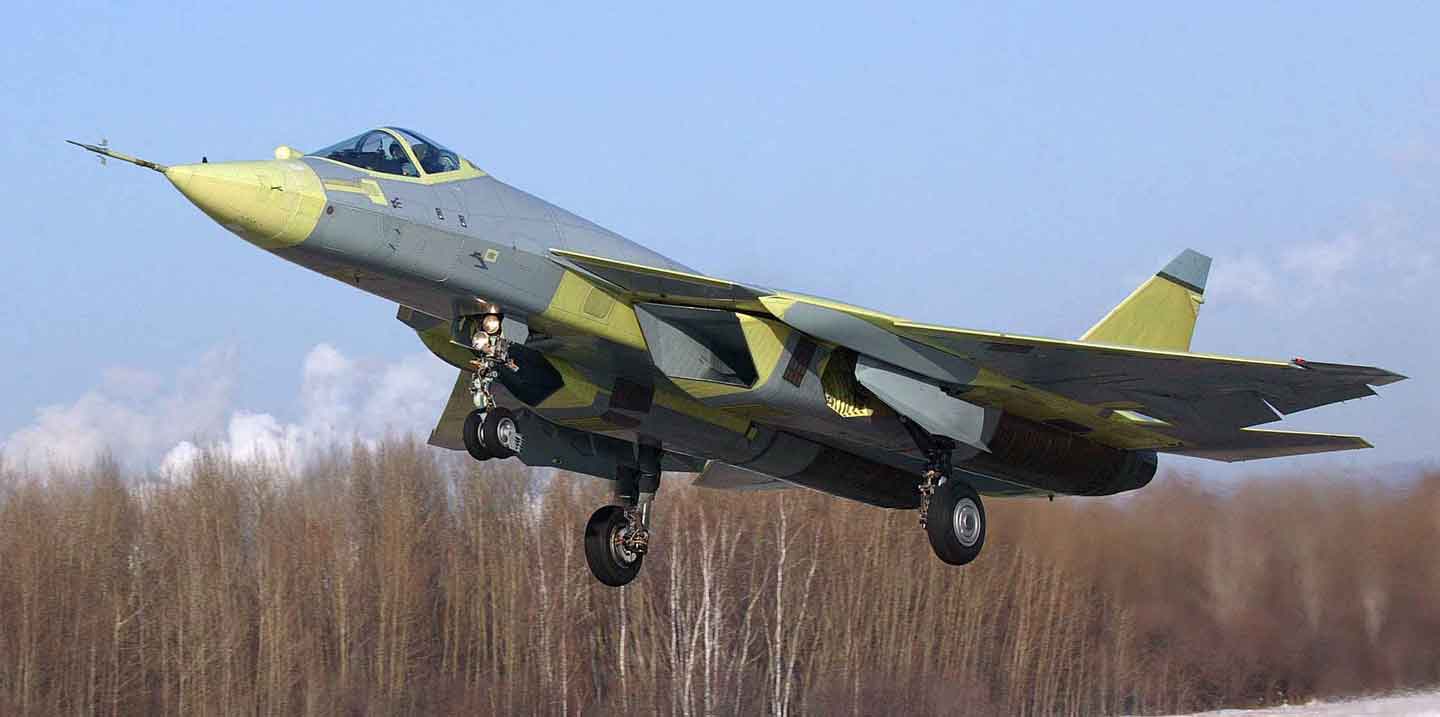Stealth technology is a sub-discipline of military tactics and passive electronic countermeasures, which covers a range of techniques used with personnel, aircraft, ships, submarines, missiles and satellites to make them less visible (ideally invisible) to radar, infrared, sonar and other detection methods.[i]
The Sukhoi PAK- FA is a fifth-generation fighter programme of the Russian Air Force. The PAK- FA is intended to be the successor to the MiG-29 and Su-27 in the Russian Air Force and serve as the basis for the FGFA.
The top militaries in the word are spending billions trying to develop or ‘acquire’ stealth technology. The United States developed stealth technology in 1960s and equipped their aircraft with the same and have since then dominated air-warfare. One of the most advanced fighter aircraft in the world, Lockheed Martin F-22 Raptor is a fifth-generation, single-seat, twin-engine, all-weather stealth tactical fighter developed for the United States Air Force (USAF). After USA, China and Russia have been pursuing fifth generation fighter aircraft programmes, both with stealth technologies- Chengdu J-20 and Sukhoi PAK-FA.
Chengdu J-20
The J-20 is a long-range radar-evading fighter jet equipped with air-to-air missiles, resembling Lockheed Martin’s F-22 Raptor. On 1 November 2016, China showcased two of its advanced stealth fighters in a fly-over at an air show in Zhuhai. China has reportedly built six prototypes of this fifth generation fighter aircraft (FGFA). The other stealth fighter, the comparatively smaller J-31, designed for only export to customers such as Pakistan, is also ready to roll out. Reportedly, Pakistan is already in talks with China for the J-31.[ii]
The People’s Liberation Air Force officials told the media that the J-20 was not being showcased on ground as public display, as visitors could not be permitted to come close because of secrecy, stating, “J-20 contains many of China’s top technologies in stealth aircraft plus other military secrets that include the J-20’s body shape, the proportion of its wing and body and other secrets as aircraft experts can easily calculate its stealth parameters from its exterior.” [iii]
Sukhoi PAK-FA
The Sukhoi PAK- FA is a fifth-generation fighter programme of the Russian Air Force. The PAK- FA is intended to be the successor to the MiG-29 and Su-27 in the Russian Air Force and serve as the basis for the FGFA. It is being co-developed by Sukhoi and Hindustan Aeronautics Limited (HAL) for the Indian Air Force. In 2007, Russia and India signed an agreement on the joint development of the Fifth-Generation Fighter Aircraft.[iv] The Indian Air Force is expected to be the initial customer for these planes, which will be subsequently supplied to third countries. While the Chinese FGFA’s are ready to roll off, the Russians cannot afford to stay far behind. Russia’s Defence Ministry announced in early 2016 that the new aircraft would be inducted in the Russian Air Force in 2017.[v]
Pakistan is China’s test market, and even though the Pakistani economy may not be able to afford the J-20, China, which has been a reliable supplier of low cost weaponry to Pakistan, could provide the J-20 at cost price.
The PAK-FA has several key advantages over competing stealth jets. For instance, at 2440 kph it is faster than both the Chinese and American aircraft. It also has a huge advantage in terms of endurance – its range of 5500 km beats the 3400 km of the American F-22. The Russian jet’s radar allows it to spot incoming threats at a distance of up to 400 km compared with the F-22’s 210 km.[vi]
Why India needs to Hasten the PAK-FA
According to reports, J-20 is to be operational from 2017 and PAK-FA from 2018 (although Russia has claimed to make PAK-FA operational by 2017). As is known, Pakistan is China’s test market, and even though the Pakistani economy may not be able to afford the J-20, China, which has been a reliable supplier of low cost weaponry to Pakistan, could provide the J-20 at cost price.
During the 1960s and 1970s Pakistan attitude changed to savage as it received the latest US jet fighters such as the F-85 Sabre, F-104 Starfighter and the F-16 Falcon. But with the arrival of the Russian MiG-29 multirole fighter in 1985 and the Sukhoi Su-30MKI in 1997 the pendulum of air superiority swung towards the IAF. Even a single stealth squadron could give the PAF a psychological edge while also terminating the IAF’s 31 year record as possessing the most advanced jets in the region. It is in this backdrop that India needs to fast track the PAK-FA.[vii]
The PLA has made its strategic lodgment in Gilgit-Baltistan under the pretext of developing hydel projects. This has been further reinforced through the development of the China-Pakistan Economic Corridor (CPEC) in which China is investing $46 billion; $11 billion by the Chinese government and balance $35 billion by private companies of China. The CPEC is actually the strategic highway of China for land access to the Indian Ocean that is emerging as the centre of gravity of future conflict.
It is in Chinese interest to keep Pakistani fears of Indian dominance alive to keep Pakistan within its orbit. The more Washington gravitates towards India, the more Beijing will tilt towards Pakistan.
The IMF and economists have cautioned that the CPEC might be an obligation trap for Pakistan as repayment obligations that come with this investment will be serious. Without any doubt China will see it through because of her own strategic interests, especially given that the Pakistani military hierarchy has more or less accepted to let Pakistan become a satellite state of China. That is why China is developing Gwadar port and its infrastructure including airfield through Chinese companies on a gratis basis.[viii]
Pakistan provides China with secure access to naval bases (Karachi, Omari and Gwadar) allowing Beijing to extend its sphere of influence to the Middle East and Central Asia. A presence in Gwadar provides China with a listening post from where it can monitor US naval activities in the Persian Gulf and Indian activities in the Arabian Sea.
It is in Chinese interest to keep Pakistani fears of Indian dominance alive to keep Pakistan within its orbit. The more Washington gravitates towards India, the more Beijing will tilt towards Pakistan. If Pakistan purchase Chinese J-20 it may draw Pakistan more into the debt trap but then China can always extend soft long-term repayment plan, even lease some of these aircraft for long periods. At the same time, basing of these aircraft flown by PLAAF is also very much possible under the pretext of training, exercises etc. That is why India needs to hasten the PAK-FA along with Russia.
The PLAAF is the largest air force in Asia and the third largest in the world, with more than 2,800 aircraft including 2,100 combat aircraft. China seeks to develop advanced aircraft to improve its regional projection capabilities and to strengthen its ability to strike regional airbases and facilities. The PLAAF has observed foreign military employment of stealth aircraft and views this technology as a core capability in its transformation from a predominantly territorial air force to one capable of conducting both offensive and defensive operations. PLAAF leaders believe stealth aircraft provide an offensive operational advantage that denies an adversary the time to mobilize and to conduct defensive operations. The PLAAF also views stealth technology as integral to unmanned aircrafts, specifically those with and air-to-ground role, as this technology would improve that system’s ability to penetrate heavily protected targets. [ix]
References
[i] https://en.wikipedia.org/wiki/Stealth_technology
[ii] Pakistan eyes Chinese J-20: It’s time for India to trot in fifth-generation fighter race: http://www.firstpost.com/world/pakistan-eyes-chinese-j-20-its-time-for-india-to-trot-in-fifth-generation-fighter-race-3102456.html
[iii] Id
[iv] https://en.wikipedia.org/wiki/Sukhoi_PAK_FA
[v] Why India needs to fast track the PAK-FA: http://in.rbth.com/blogs/stranger_than_fiction/2016/06/10/why-india-needs-to-fast-track-the-pak-fa_601731
[vi] Id
[vii] Ibid
[viii] Supra note 2
[ix] Annual Report to Congress
Courtesy: www.claws.in






Report has appeared on 21 December , 2018 in Asian Times Online carrying it from NYT to say that China and Pakistan have hatched ‘secret’ plan to build new fighter Jets. It seems the suggestion is that such a build -up is planned to be carried out in Pakistan, which has obvious signals of worry for India. The worrisome news for India has come just when the present year 2018 is bowing out in a little over week’s time to pave way for new year 2019. It may ,however , be relevant to bring in this Vedic astrology writer’s alert for more care and appropriate strategy in article – “ The Year 2019 Astrologically for India” – published as early as on 7 October , 2018 at theindiapost.com ( https://www.theindiapost.com/headline/the-year-2019-astrologically-for-india/ . The text in the article related to the point here reads as :-
“ February- March2019. These nearly two months appear to be calling for more care and appropriate strategy in relation to more than one front. Be on guard against war or war like postures of China and Pakistan”. So the alert meant that some worrisome concern from across the border could come early in 2019 , more so in February-March. So related worrisome news has indeed come when just a week is left for 2019 to begin.
Major Chinese weapon systems have not been tested in battle conditions. It is too early to raise an alarm about the J-20s. We need to upgrade our AWACs and have the requisite counter-measures for any induction of advanced air platforms in the neighbourhood.
PAKFA is not the answer to a stealth aircraft in the air forces of our neighbours. What we need is the means to detect and kill stealth aircraft. Defence against a sword is by a shield, not another sword.
The reason we could use a PAKFA or equivalent is NOT because China gets J-20s but because it will give us some stealth based penetration capability, not defence against J-20.
J-20 will never work, so do not vase decisions on Pakistan acquiring Chinese stealth fighter. They know it but keep young analysts confused they will keep on making beeline towards this fighter.